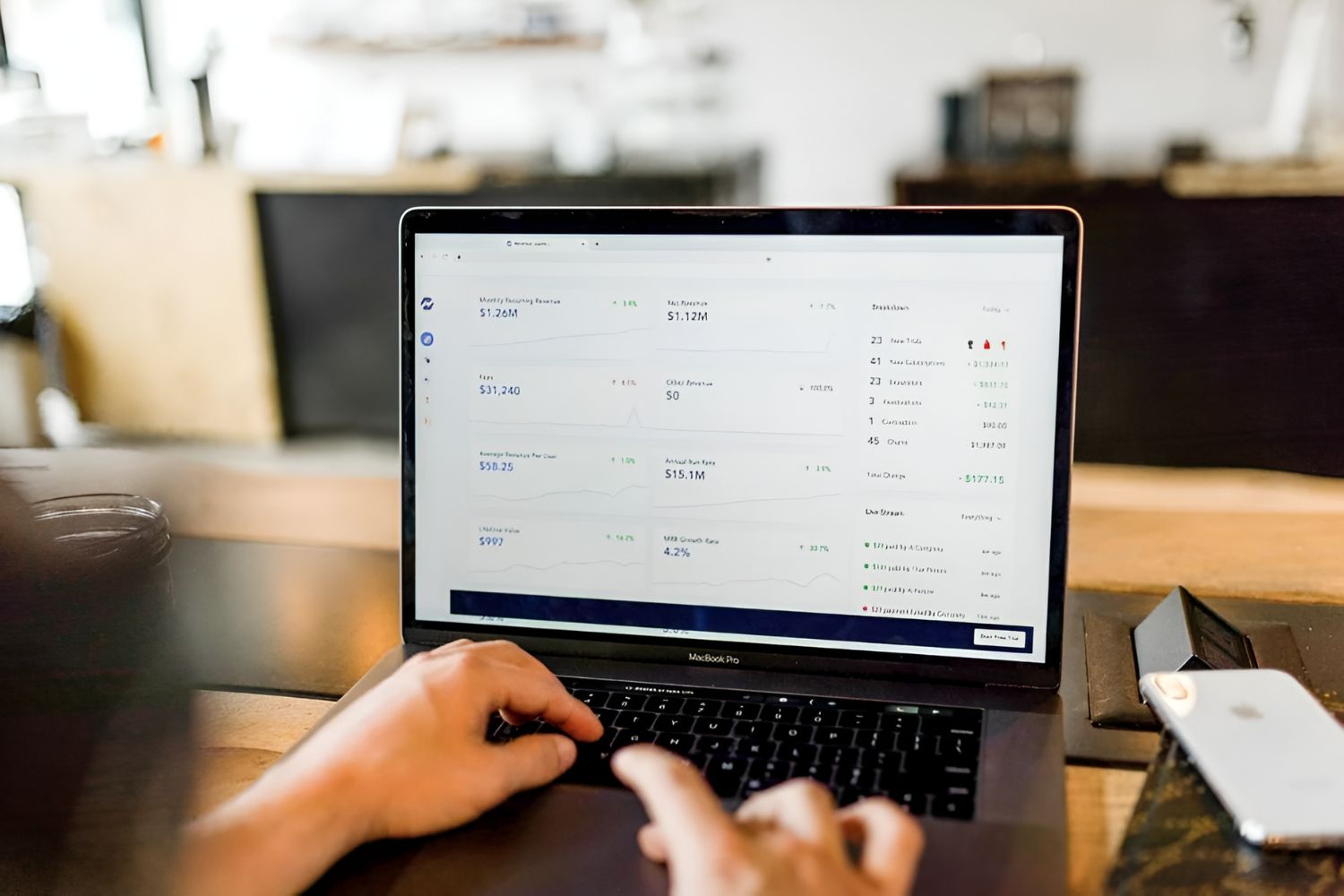Introduction
Welcome to the world of Software as a Service (SaaS) companies. In today’s digital age, SaaS companies have become a dominant force in the technology industry, providing businesses and individuals with innovative solutions delivered through cloud-based platforms. As a result, valuing SaaS companies has become an essential task for investors, analysts, and entrepreneurs.
Valuing a SaaS company requires a comprehensive understanding of its unique characteristics and key metrics. Unlike traditional businesses, SaaS companies generate revenue through subscriptions, which presents both advantages and challenges when it comes to valuation.
In this article, we will delve into the intricacies of valuing SaaS companies. We will explore the key metrics and factors that investors and analysts consider when evaluating the worth of a SaaS company. By understanding these essential elements, you will be better equipped to assess the value and potential of a SaaS company.
It is crucial to note that valuing SaaS companies is not a one-size-fits-all approach. Each company is different, with varying growth rates, customer acquisition costs, churn rates, and market potential. Consequently, a holistic evaluation is necessary to account for these unique aspects and make an informed valuation.
Throughout this article, we will explore the most critical factors that go into valuing SaaS companies. We will discuss revenue growth, churn rate, customer acquisition costs, lifetime value of customers, market size and potential, profitability and margins, competitive landscape, and SaaS valuation multiples.
So, whether you are an investor looking to make strategic decisions or an entrepreneur aiming to assess the value of your SaaS company, join us on this journey to uncover the secrets behind valuing SaaS companies and make data-driven decisions that drive success.
Understanding SaaS Companies
Before diving into the intricacies of valuing SaaS companies, it is essential to have a solid understanding of what SaaS companies are and how they operate. Software as a Service (SaaS) companies provide cloud-based software solutions to businesses and individuals, delivering services over the internet instead of requiring software installations on individual devices. This model offers numerous benefits, such as scalability, accessibility, and cost-effectiveness.
One of the defining characteristics of SaaS companies is their revenue model. Instead of selling perpetual licenses or one-time purchases, SaaS companies generate revenue through subscription-based services. Customers pay a recurring fee to access the software, typically on a monthly or annual basis. This subscription model ensures a steady stream of revenue and allows for better long-term planning and scalability.
Furthermore, SaaS companies leverage cloud-based infrastructure to provide their services. This means that all the software and data are stored and managed on remote servers, providing users with the ability to access the software from anywhere with an internet connection. This flexibility revolutionizes the way businesses and individuals interact with and utilize software
In addition to the subscription-based revenue model and cloud infrastructure, SaaS companies often prioritize customer success and satisfaction. Since customers have the flexibility to cancel their subscriptions, SaaS companies strive to provide exceptional service, continuous updates, and valuable functionalities to retain customers and minimize churn.
The business models of SaaS companies can vary widely. Some focus on serving specific industries or niches, while others aim for a broader market. Additionally, SaaS companies employ various pricing models, such as tiered pricing, metered usage, or usage-based pricing, to cater to different customer needs and budgets.
Overall, SaaS companies are at the forefront of technological innovation, providing businesses and individuals with software solutions that are flexible, scalable, and cost-effective. Understanding these fundamental aspects of SaaS companies is crucial when it comes to valuing them accurately and evaluating their potential for growth and profitability.
Identifying Key Metrics
When valuing SaaS companies, it is important to identify and analyze key metrics that provide insights into the company’s performance, growth potential, and overall value. These metrics serve as a foundation for evaluating the health and success of a SaaS business.
One of the primary metrics to consider is revenue growth. SaaS companies with consistent and strong revenue growth demonstrate their ability to attract new customers, retain existing ones, and expand their market presence. Investors and analysts look for a high growth rate in annual recurring revenue (ARR) or monthly recurring revenue (MRR) to gauge the company’s potential for generating long-term revenue streams.
Another crucial metric to examine is the churn rate. Churn refers to the percentage of customers who cancel their subscriptions within a specific period. A high churn rate can indicate issues with product-market fit, customer satisfaction, or competition. On the other hand, a low churn rate demonstrates customer loyalty and satisfaction, contributing to the stability and growth of the company.
Customer acquisition costs (CAC) are also significant metrics that impact the valuation of a SaaS company. CAC represents the costs associated with acquiring new customers, including marketing expenses, sales team salaries, and advertising costs. A lower CAC relative to the customer lifetime value (LTV) signifies efficient customer acquisition, indicating a healthier business model and higher long-term profitability.
The lifetime value of customers (LTV) is a critical metric that measures the total revenue a SaaS company can expect from a single customer over their entire engagement with the company. A high LTV indicates strong customer retention and the ability to generate recurring revenue from existing customers, which is key to sustained growth and profitability.
Market size and potential should also be considered when valuing a SaaS company. Assessing the target market’s size, growth rate, and competition helps determine the company’s growth potential and market share. SaaS companies operating in large and expanding markets generally have more opportunities for customer acquisition and revenue growth.
Furthermore, profitability and margins play a vital role in valuing SaaS companies. While some early-stage SaaS companies prioritize growth over profitability, profitability indicators like gross margin, net margin, and operating margin are crucial for determining the long-term sustainability and value of a SaaS company.
Overall, identifying and analyzing these key metrics provides a comprehensive understanding of a SaaS company’s performance, growth potential, and overall value. Successful valuation requires examining how these metrics interrelate and the trends they present, enabling informed decision-making for investors, analysts, and stakeholders.
Evaluating Revenue Growth
Revenue growth is a crucial metric when evaluating the value of a SaaS company. It provides valuable insights into the company’s ability to attract and retain customers, expand its market presence, and generate sustainable revenue streams. As a result, investors and analysts closely examine revenue growth to assess the company’s potential for long-term success.
There are several factors to consider when evaluating revenue growth. The first is the overall growth rate of the company’s annual recurring revenue (ARR) or monthly recurring revenue (MRR). These metrics indicate the recurring revenue that the company earns from its customers on an annual or monthly basis. A high growth rate signifies strong customer acquisition, expansion into new markets, and the ability to upsell and cross-sell existing customers.
It is also important to analyze the sources of revenue growth. Is the growth driven primarily by new customer acquisition or by upselling and expanding within the existing customer base? Understanding the underlying drivers of revenue growth provides insights into the company’s customer acquisition strategies, market positioning, and ability to extract maximum value from their customer relationships.
Furthermore, evaluating revenue growth requires considering the company’s sales and marketing strategies. Are they investing heavily in sales and marketing activities to drive revenue growth, or are they relying on organic growth and customer referrals? Assessing the efficiency and effectiveness of the company’s sales and marketing efforts helps gauge the sustainability and scalability of their revenue growth.
It’s also important to analyze the growth rate of specific customer segments or market segments. Is the company experiencing faster growth in particular industries or regions? This information can help identify potential growth opportunities and target markets that contribute significantly to the company’s overall revenue growth.
A long-term view of revenue growth is crucial when evaluating SaaS companies. Sustainable revenue growth is typically prioritized over short-term spikes. Companies that consistently demonstrate a steady and upward revenue growth trajectory are viewed more favorably by investors and are likely to have higher valuations.
It is worth noting that while revenue growth is essential, it should be evaluated alongside other metrics such as churn rate and customer acquisition costs. Understanding the relationship between revenue growth and these other factors provides a more comprehensive picture of the company’s overall performance and financial health.
In summary, evaluating revenue growth is a critical aspect of valuing SaaS companies. Analyzing the growth rate, sources of growth, sales and marketing strategies, customer segments, and long-term sustainability provides valuable insights into the company’s potential for success and helps stakeholders make informed investment decisions.
Analyzing Churn Rate
Churn rate is a key metric that plays a significant role in evaluating the value of a SaaS company. It measures the percentage of customers who cancel their subscriptions or do not renew within a specific period. Analyzing churn rate provides insights into customer retention, satisfaction, and the overall health of the company’s subscription base.
A high churn rate can be indicative of various underlying issues. It may suggest that customers are dissatisfied with the product, experiencing difficulties in using it, or not deriving sufficient value from it. Conversely, a low churn rate indicates strong customer loyalty and satisfaction, which are positive indicators of the company’s ability to retain existing customers and generate recurring revenue.
When analyzing churn rate, it is important to distinguish between two types: gross churn and net churn. Gross churn measures the overall number or percentage of customers lost, while net churn takes into account expansion revenue from existing customers. Net churn provides a more comprehensive view of the company’s ability to not only retain customers but also grow revenue through upselling, cross-selling, or expanding services within the existing customer base.
Furthermore, it is valuable to analyze churn rate across different customer segments. Are certain segments experiencing higher churn than others? Identifying the drivers of churn within specific customer segments can help the company tailor retention strategies and allocate resources to address specific areas of concern.
Effective customer success and retention strategies are crucial for reducing churn rate. SaaS companies often invest in activities such as onboarding, training, and customer support to ensure that customers fully understand and utilize the product. It is also essential to proactively engage with customers, understand their needs, and continually provide value to prevent them from seeking alternative solutions.
Moreover, analyzing churn rate in conjunction with customer acquisition costs (CAC) provides valuable insights into the company’s financial health and growth potential. If the cost of acquiring new customers exceeds the revenue generated from them before they churn, the company may face significant challenges in achieving profitability and long-term sustainability. Balancing customer acquisition costs with churn rate is vital for a healthy business model.
Overall, analyzing churn rate is critical when valuing SaaS companies. It sheds light on customer satisfaction, loyalty, and the company’s ability to retain and grow its customer base. By understanding the underlying causes of churn and implementing effective customer success strategies, SaaS companies can minimize churn, increase customer retention, and strengthen their overall value proposition.
Assessing Customer Acquisition Costs
Assessing customer acquisition costs (CAC) is a crucial step in valuing a SaaS company. Understanding how much it costs to acquire a new customer provides insights into the efficiency and effectiveness of the company’s sales and marketing strategies. It also influences the company’s profitability and long-term growth potential.
CAC encompasses all the costs associated with acquiring new customers, including marketing expenses, sales team salaries, advertising costs, and any other costs incurred during the sales process. Calculating CAC involves dividing the total acquisition costs by the number of new customers acquired within a specific period.
One way to assess CAC is to analyze the company’s customer acquisition channels. Understanding which channels, such as online advertising, content marketing, or referral programs, are driving new customer acquisition and their associated costs helps identify the most effective and efficient channels. It also allows for targeted optimization of marketing efforts to achieve better results at a lower acquisition cost.
Another important aspect of assessing CAC is considering the customer lifetime value (LTV). LTV represents the total revenue a SaaS company can expect to generate from a single customer over their entire engagement with the company. Comparing CAC to LTV allows stakeholders to assess the cost-effectiveness of acquiring new customers relative to their potential lifetime value. Ideally, the CAC should be significantly lower than the LTV to indicate a healthy and sustainable business model.
Understanding the payback period is also valuable when assessing CAC. The payback period is the length of time it takes for a company to recover the CAC through the revenue generated from the new customers. A shorter payback period indicates faster revenue realization and a more efficient use of resources in customer acquisition.
It is worth noting that CAC can vary depending on various factors, including the target market, competition, and customer acquisition strategies. Different customer segments or markets may require different acquisition approaches, resulting in varying CAC. Assessing CAC on a granular level, such as by customer segment or marketing campaign, can provide deeper insights into the effectiveness of different strategies and their associated costs.
Moreover, analyzing trends in CAC over time is essential. Are the acquisition costs increasing or decreasing? Identifying trends helps evaluate the scalability of the business model and the company’s ability to acquire customers efficiently as it grows.
In summary, assessing customer acquisition costs is crucial when valuing a SaaS company. Analyzing the costs associated with acquiring new customers, evaluating the effectiveness of acquisition channels, comparing CAC to LTV, and considering the payback period provides valuable insights into the efficiency of the company’s sales and marketing efforts. Achieving a balance between customer acquisition costs and the potential lifetime value of customers is essential for sustainable growth and profitability.
Examining Lifetime Value of Customers
Examining the lifetime value of customers (LTV) is a critical aspect of valuing a SaaS company. LTV represents the total revenue a company can expect to generate from a single customer over their entire engagement with the company. Understanding LTV provides insights into the long-term revenue potential, customer retention, and overall value of the company.
To calculate LTV, it is necessary to consider various factors, including the average revenue per customer, the length of the customer relationship, and the gross margin. The formula for LTV is generally LTV = (average revenue per customer) × (customer relationship length) × (gross margin).
Analyze the average revenue per customer, which includes monthly or annual subscription fees, additional usage fees, or fees for any upsells or cross-sells. By quantifying the revenue generated per customer, you gain insights into the revenue potential of the customer base. Additionally, analyzing variations in average revenue per customer across different customer segments can help identify opportunities for growth and optimization.
Assess the length of the customer relationship when examining LTV. Longer customer relationships generally result in higher LTV. Factors that contribute to longer customer relationships include customer satisfaction, product stickiness, and the ability to continually deliver value to customers over time. SaaS companies often strive to build strong customer relationships through exceptional customer support, continuous product updates, and personalized experiences.
The gross margin is a significant factor in LTV analysis. Gross margin represents the difference between the revenue generated and the direct costs associated with delivering the product or service. SaaS companies with higher gross margins have more profitability potential and can invest more resources in acquiring and retaining customers. A higher gross margin positively impacts LTV and contributes to the overall value of the company.
Another aspect to consider when examining LTV is customer retention. A higher customer retention rate leads to longer customer relationships and, therefore, a higher LTV. SaaS companies with strong customer retention strategies, such as proactive customer support, tailored experiences, and continuous value delivery, have a higher likelihood of increasing LTV and driving long-term revenue growth.
It is important to note that LTV should be evaluated in conjunction with other metrics, such as customer acquisition costs (CAC) and churn rate. Comparing LTV to CAC allows you to assess the efficiency of customer acquisition relative to the potential revenue generated. Additionally, evaluating LTV in relation to the churn rate provides insights into customer retention and the sustainability of the company’s revenue streams.
Examining LTV allows investors and stakeholders to assess the long-term revenue potential of a SaaS company. By understanding the average revenue per customer, customer relationship length, gross margin, and customer retention, it is possible to gain a comprehensive view of the company’s ability to generate recurring revenue and sustain profitability over an extended period.
Evaluating Market Size and Potential
Evaluating the market size and potential is a crucial factor when valuing a SaaS company. Understanding the market within which a company operates provides insights into its growth opportunities, competitive landscape, and overall value proposition. Assessing market size and potential helps investors and stakeholders gauge the scalability and long-term viability of the company.
Market size refers to the total addressable market (TAM) for the company’s product or service. It represents the total potential revenue the company could capture if it were to capture 100% market share. Analyzing the market size helps ascertain whether the company has ample room to grow and expand its customer base. Companies operating in larger markets generally have more growth opportunities and potential for revenue generation.
In addition to market size, it is crucial to assess the market’s growth rate. A rapidly growing market presents more opportunities for a SaaS company to acquire customers and generate revenue. High growth markets indicate increasing demand for the company’s products or services, allowing for rapid expansion and potential market dominance.
Understanding the competitive landscape within the market is also vital. Analyze the number and strength of competitors, their market share, and their competitive advantages. Identifying direct and indirect competitors helps evaluate the company’s positioning and ability to differentiate itself in the market. A competitive market may require additional marketing efforts and differentiation strategies to capture and retain customers.
Moreover, analyzing the target market’s characteristics and needs is essential. Is the market underserved, with customers lacking adequate solutions? Identifying market pain points and gaps allows the company to tailor its products or services to meet customer needs and gain a competitive edge. Recognizing market trends and shifts in customer preferences is crucial when assessing the long-term potential of the market.
Assessing the market size and potential is not limited to the immediate present. Consider future trends, technological advancements, and changing customer behaviors that may impact the market. Understanding the market’s potential for expansion and adaptation to evolving industry trends provides a more thorough evaluation of the company’s growth opportunities and potential market share.
Lastly, it is worth noting that market size and potential can vary across different geographic regions. Analyzing market size and potential in different geographical areas helps identify potential growth opportunities and expansion possibilities for the company.
In summary, evaluating the market size and potential is crucial when valuing a SaaS company. Assessing the market’s size, growth rate, competitive landscape, customer needs, and future trends provides insights into the company’s growth potential, market positioning, and value proposition. Understanding the market’s size and potential allows investors and stakeholders to make informed decisions and assessments of the company’s long-term potential for success.
Understanding Profitability and Margins
Understanding profitability and margins is a crucial aspect when valuing a SaaS company. It provides insights into the company’s financial health, sustainability, and potential for long-term profitability. Assessing profitability and margins helps investors and stakeholders evaluate the company’s ability to generate sustainable revenue and achieve a favorable return on investment.
Gross margin is one of the key metrics to consider. It represents the difference between the revenue generated and the direct costs associated with delivering the product or service. A higher gross margin indicates a higher percentage of revenue retained after accounting for direct costs. SaaS companies with a high gross margin are generally more profitable and have greater flexibility to invest in growth initiatives and manage expenses.
Another important profitability metric to analyze is the net margin. The net margin represents the percentage of revenue that remains after deducting all expenses, including not only direct costs but also indirect costs such as overhead expenses, sales and marketing expenses, administrative costs, and research and development costs. A healthy net margin indicates that the company is effectively managing its expenses and generating sustainable profits.
A positive cash flow is also crucial when assessing profitability. While a company may be generating revenue and reporting profitability, it is essential to analyze the actual cash flow to ensure the company has sufficient funds to meet its financial obligations and fuel future growth.
In addition to profitability, analyzing margins is essential. SaaS companies often operate with high gross margins due to the scalability of their software products. Analyzing the trend and stability of margins over time provides insights into the company’s ability to maintain profitability as it grows and scales its operations.
It is also important to consider the impact of customer acquisition costs (CAC) and churn rate on profitability. If the cost of acquiring new customers exceeds the revenue generated from them before they churn, the company may face challenges in achieving profitability. Balancing customer acquisition costs with revenue generated from customers is vital for a sustainable business model with positive profitability.
Furthermore, evaluating profitability and margins in comparison to industry benchmarks is valuable. Benchmarking allows for a comparison of the company’s financial performance against industry peers and provides insights into the company’s competitiveness and potential for improvement.
Lastly, understanding profitability and margins goes beyond financial metrics. It is crucial to evaluate the company’s strategy, execution, market positioning, and differentiation. A strong value proposition, competitive advantage, and efficient operations contribute to profitability and sustainable margin levels.
In summary, understanding profitability and margins is fundamental when valuing a SaaS company. Analyzing gross margin, net margin, cash flow, and margins in comparison to industry benchmarks provides insights into the company’s financial health, sustainability, and potential for long-term profitability. Evaluating profitability in the context of customer acquisition costs, churn rate, and overall market conditions allows for a comprehensive assessment of the company’s financial performance and value proposition.
Considering Competitive Landscape
Considering the competitive landscape is a critical aspect when valuing a SaaS company. Understanding the company’s position within the market and the dynamics of the competitive landscape provides insights into its differentiation, growth potential, and overall value proposition. Analyzing the competitive landscape helps investors and stakeholders assess the company’s ability to navigate and succeed in a crowded marketplace.
One of the key factors to consider is the number and strength of competitors within the industry. Assessing the level of competition helps evaluate the barriers to entry and the potential challenges the company may face in acquiring and retaining customers. Understanding the competitive landscape enables the company to identify its unique selling points and differentiate itself from competitors.
Analyzing competitors’ market share is also essential. Understanding the market share held by each competitor provides insights into the company’s current standing within the market and its growth potential. Additionally, evaluating the growth rate of competitors and their market penetration helps identify trends and potential challenges the company may face in capturing market share.
It is valuable to identify the competitive advantages of the company compared to its competitors. Assessing factors such as technology, product features, pricing strategies, and customer service allows stakeholders to evaluate the company’s ability to attract and retain customers in the face of competition. Differentiation and unique value propositions play a crucial role in gaining a competitive edge.
Furthermore, understanding the target market or customer segments and their preferences is crucial when evaluating the competitive landscape. Analyzing customer needs, pain points, and preferences in relation to the solutions offered by competitors helps identify opportunities for the company to position itself and capture market share. Tailoring products, services, and marketing efforts based on these insights increases the company’s competitiveness and appeal to target customers.
Evaluating the company’s ability to react and adapt to market changes and evolving customer needs is important. Agility and innovation are key factors in staying ahead of the competition and capitalizing on emerging opportunities. Understanding the company’s investment in research and development, product updates, and staying up-to-date with industry trends provides insights into its potential for growth and sustainability.
Lastly, it is important to assess potential future entrants or disruptive technologies that could impact the competitive landscape. Identifying potential threats and understanding the company’s preparedness to respond and stay competitive is critical for long-term success.
In summary, considering the competitive landscape is essential when valuing a SaaS company. Analyzing the number and strength of competitors, market share, competitive advantages, target market preferences, and the company’s ability to adapt to market changes provides insights into its differentiation, growth potential, and overall value proposition. Understanding the competitive landscape enables stakeholders to make informed decisions and assessments of the company’s potential for success in a competitive market.
Assessing SaaS Valuation Multiples
Assessing SaaS valuation multiples is an important step when valuing a SaaS company. Valuation multiples provide a benchmark for comparing the company’s value to its financial performance and industry peers. Understanding valuation multiples helps investors and stakeholders determine a reasonable valuation range and make informed investment decisions.
One common valuation multiple used in the SaaS industry is the price-to-sales (P/S) ratio. The P/S ratio compares the company’s market capitalization (or enterprise value) to its annual revenue. It measures the market’s willingness to pay for each dollar of the company’s revenue. A higher P/S ratio typically indicates higher growth expectations and market optimism. However, it is important to consider other factors such as profitability, growth potential, and competitive landscape when interpreting the P/S ratio.
The price-to-earnings (P/E) ratio is another valuation multiple frequently used in the evaluation of SaaS companies. The P/E ratio compares the company’s market value to its earnings, specifically the net income or earnings per share. It provides an indication of how much investors are willing to pay for each dollar of the company’s earnings. A higher P/E ratio suggests greater growth expectations and investor confidence in the company’s future earnings potential.
Another relevant valuation multiple in the SaaS industry is the enterprise value/EBITDA (EV/EBITDA) ratio. The EV/EBITDA ratio compares the company’s enterprise value (market capitalization plus debt minus cash) to its earnings before interest, taxes, depreciation, and amortization (EBITDA). This multiple helps account for factors such as debt and allows for a more accurate assessment of the company’s operating profitability. A lower EV/EBITDA ratio may indicate that the company is undervalued or has a lower level of leverage compared to industry peers. However, it is important to consider other factors such as growth potential and industry norms when interpreting this ratio.
In addition to these commonly used valuation multiples, there may be industry-specific multiples based on the unique characteristics of SaaS companies. These multiples could include metrics related to customer acquisition costs, churn rate, or other financial and operational metrics specific to the SaaS industry. It is essential to research and consider these industry-specific multiples to gain a more comprehensive understanding of the company’s valuation.
It is important to note that valuation multiples are just one piece of the puzzle when assessing a SaaS company’s value. They should be used in conjunction with other key metrics, such as revenue growth, profitability, competitive landscape, and market potential. Additionally, it is important to compare the valuation multiples of the company to its industry peers to gain a relative perspective.
In summary, assessing SaaS valuation multiples is a crucial aspect when valuing a SaaS company. Understanding and analyzing multiples such as the P/S ratio, P/E ratio, and EV/EBITDA ratio provide valuable insights into the market’s perception of the company’s value. However, it is important to consider other factors and industry-specific metrics to gain a more comprehensive and accurate assessment of the company’s valuation.
Conclusion
Valuing SaaS companies requires careful analysis and consideration of numerous factors, metrics, and industry dynamics. Throughout this article, we explored the key elements involved in valuing SaaS companies, providing a comprehensive understanding of how to assess their worth.
We began by understanding the fundamentals of SaaS companies, including their revenue model, subscription-based services, and cloud-based infrastructure. With this foundation, we delved into identifying key metrics such as revenue growth, churn rate, customer acquisition costs, and lifetime value of customers. These metrics provide insights into a company’s performance, growth potential, and overall value.
Additionally, we emphasized the importance of evaluating the market size and potential, considering the competitive landscape, and assessing profitability and margins. These factors help determine the company’s positioning, growth opportunities, and long-term sustainability.
Lastly, we discussed the assessment of SaaS valuation multiples, such as the P/S ratio, P/E ratio, and EV/EBITDA ratio. These multiples serve as benchmarks for comparing the company’s value to its financial performance and industry peers. However, it is vital to consider other factors and industry-specific metrics to gain a comprehensive understanding of the company’s valuation.
Valuing SaaS companies is an intricate process that requires a holistic approach, considering multiple perspectives, trends, and metrics. By evaluating these aspects, investors, analysts, and stakeholders can make informed decisions and assessments of a SaaS company’s value and potential for success.
Ultimately, valuing SaaS companies is both an art and a science. It requires a deep understanding of the industry, market dynamics, financial performance, and growth potential. The continuous evolution of the SaaS landscape also demands staying updated with industry trends and adapting valuation methodologies accordingly.
As the SaaS industry continues to thrive and reshape the technology landscape, the ability to accurately value SaaS companies becomes increasingly important. By leveraging the insights gained from this article, stakeholders can make sound investment decisions, support strategic initiatives, and maximize the potential of SaaS companies in a dynamic and competitive market.

























